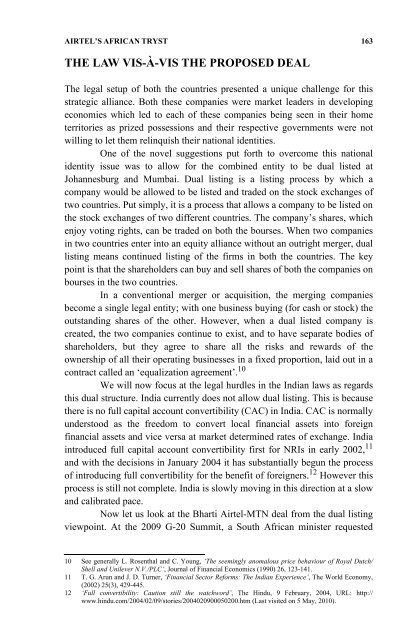University of Botswana Law Journal - PULP
University of Botswana Law Journal - PULP
University of Botswana Law Journal - PULP
Create successful ePaper yourself
Turn your PDF publications into a flip-book with our unique Google optimized e-Paper software.
AIRTEL’S AFRICAN TRYST 163<br />
THE LAW VIS-À-VIS THE PROPOSED DEAL<br />
The legal setup <strong>of</strong> both the countries presented a unique challenge for this<br />
strategic alliance. Both these companies were market leaders in developing<br />
economies which led to each <strong>of</strong> these companies being seen in their home<br />
territories as prized possessions and their respective governments were not<br />
willing to let them relinquish their national identities.<br />
One <strong>of</strong> the novel suggestions put forth to overcome this national<br />
identity issue was to allow for the combined entity to be dual listed at<br />
Johannesburg and Mumbai. Dual listing is a listing process by which a<br />
company would be allowed to be listed and traded on the stock exchanges <strong>of</strong><br />
two countries. Put simply, it is a process that allows a company to be listed on<br />
the stock exchanges <strong>of</strong> two different countries. The company’s shares, which<br />
enjoy voting rights, can be traded on both the bourses. When two companies<br />
in two countries enter into an equity alliance without an outright merger, dual<br />
listing means continued listing <strong>of</strong> the firms in both the countries. The key<br />
point is that the shareholders can buy and sell shares <strong>of</strong> both the companies on<br />
bourses in the two countries.<br />
In a conventional merger or acquisition, the merging companies<br />
become a single legal entity; with one business buying (for cash or stock) the<br />
outstanding shares <strong>of</strong> the other. However, when a dual listed company is<br />
created, the two companies continue to exist, and to have separate bodies <strong>of</strong><br />
shareholders, but they agree to share all the risks and rewards <strong>of</strong> the<br />
ownership <strong>of</strong> all their operating businesses in a fixed proportion, laid out in a<br />
contract called an ‘equalization agreement’. 10<br />
We will now focus at the legal hurdles in the Indian laws as regards<br />
this dual structure. India currently does not allow dual listing. This is because<br />
there is no full capital account convertibility (CAC) in India. CAC is normally<br />
understood as the freedom to convert local financial assets into foreign<br />
financial assets and vice versa at market determined rates <strong>of</strong> exchange. India<br />
introduced full capital account convertibility first for NRIs in early 2002, 11<br />
and with the decisions in January 2004 it has substantially begun the process<br />
<strong>of</strong> introducing full convertibility for the benefit <strong>of</strong> foreigners. 12 However this<br />
process is still not complete. India is slowly moving in this direction at a slow<br />
and calibrated pace.<br />
Now let us look at the Bharti Airtel-MTN deal from the dual listing<br />
viewpoint. At the 2009 G-20 Summit, a South African minister requested<br />
10 See generally L. Rosenthal and C. Young, ‘The seemingly anomalous price behaviour <strong>of</strong> Royal Dutch/<br />
Shell and Unilever N.V./PLC’, <strong>Journal</strong> <strong>of</strong> Financial Economics (1990) 26, 123-141.<br />
11 T. G. Arun and J. D. Turner, ‘Financial Sector Reforms: The Indian Experience’, The World Economy,<br />
(2002) 25(3), 429-445.<br />
12 ‘Full convertibility: Caution still the watchword’, The Hindu, 9 February, 2004, URL: http://<br />
www.hindu.com/2004/02/09/stories/2004020900050200.htm (Last visited on 5 May, 2010).
















